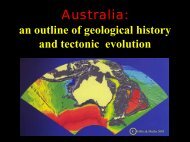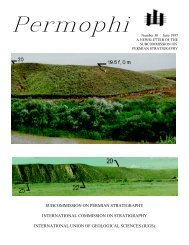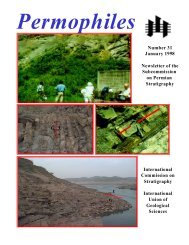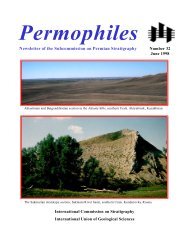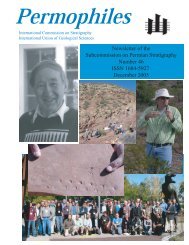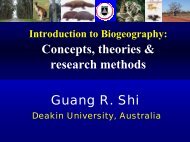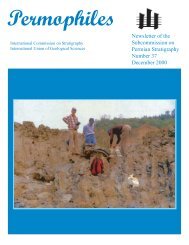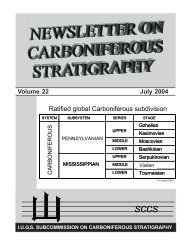Meishanian. They proposed that the boundary between these twosubstages was defined by the earliest occurrence of Clarkinachangxingensis at the base of bed 13 of the D section at Meishan,Changxing. This boundary definition cannot be accepted, becauseClarkina changxingensis appears very early in bed 10 accordingto Mei et al. (1998) (see Text-fig 1 from Mei et al., 1998), whichcoincides with or is even earlier than “the first occurrence ofClarkina subcarinata (sensu strictu), which is at 13.71 m abovethe base of the Changxing Limestone at the Meishan (D) section”,as proposed by Wardlaw and Mei (in Jin, 2000a). Therefore, thisdefinition for the base of the Meishanian substage is of no value(Wang et al.,2000).From the facts mentioned above, it is clear that the definitionsfor the Changhsingian and its substage, based on conodonts, iscurrently too premature. Current conodont taxonomy is very unstable.Much more extensive work on conodont taxonomy, especiallyon the morphoclines from late Wuchiapingian Clarkina toChanghsingian Clarkina needs to be undertaken prior to suchboundary definitions.Some problems on the Meishan section of Changxing County asthe Changsingian basal boundary stratotype.An obvious gap exists between the Longtan Formation andChanghsing Limestone. Some basal conglomerates are distributedrandomly in the lower part of the Changhsin Limestone. Majorfacies changes occur between the Longtan Formation andChanghsing Limestone. The lower part of the Changhsing Limestoneis a shallow water facies deposits; there are neither ammonoidsnor radiolarians present. Conodont evolutionary lineages cannotbe well studied because the deposits between the Longtan andChanghsing formations are not continuous. For this reason, thecorrelation potential is poor at present. Mei wants to put the baseof the Changhsingian Stage at a horizon about 2 m above the baseof the Changhsing Limestone within Bed 3 or 4, but this point hasan obvious artificial factor because Mei et al. (2001a,b) are tryingto establish a so-called golden column (two golden spikes at thesame section); they change their taxonomy rapidly for establishmentof the basal Changhsingian GSSP at the Meishan section.Below this point there is not enough exposed sequence, as wouldbe necessary for a good GSSP position.Desirable area and sections for the basal Changhsingian StageGSSP.Northwestern Hunan and Western Hubei are the best areas inChina for the study of Late Permian conodonts. In these areas,there are typical basinal facies in the upper Dalong Formation orChanghsing Limestone of the Rencunping, Xiaofutou and Jiangyasections. The lower parts of the Dalong or Changhsing formationsof these sections have typical basin-margin and slope facies. Bothformations conformably overlie the Wuchiaping Formation accordingto the analysis of Tian (1993b).In this area many ammonoids and radiolarians as well as foraminifershave been found in addition to conodonts (Tian 1993b,plate II; Chen, 2002 in press), especially in the lower parts of theDalong or Changhsing formations. This is very important for internationalcorrelation and therefore these sections have a great correlationpotential. Conodont evolutionary lineage between upper<strong>Permophiles</strong> Issue #39 200110Wuchiapingian and lower Changhsingian can be studied in conodont-richcontinuous sections.Introduction to two sections:a. Huangyan(Yellow Stone) section. This section is locatednear the border of Hubei and Sichuan, in Jianshi County of Hubei;it was first studied by Chen Li-de (2002, in press). The 56m thickDalong Formation is mainly composed of limestone, siliceous limestoneand calcareous mudstone. In the basal part of the DalongFormation, Chen Li-de (2002, in press) has found the Wuchiapingianammonoids Konlingites sp. and Sanyannites sp. and the conodontClarkina orientalis (Barskov & Koroleva). In the middlepart of the Dalong Formation, the Changhsingian ammonoidsTapashanites sp., Pseudotirolites sp., Changhsingoceras sp. andPleuronodoceras sp. have been found. It can be clearly demonstratedthat the base of the Changhsingian Stage should be withinthe lower part of the middle Dalong Formation in continuous deposits.Chen Li-de believes that the base of the Changhsingianshould be within the 2m thick interval between Bed 20 and Bed 26.This section contains abundant radiolarians, but unfortunatelythey have not been studied. Conodont samples were collected inDec. 2001 and are currently being processed. The presence ofseveral ash beds in the Dalong Formation, which will allow radiometricage determinations, is very important.b. Jiangya section. Tian(1993b) has pointed out that the lowerpart of the Dalong (Changxing) Formation is a typical basin marginand slope facies, containing extremely abundant conodonts (severalthousand per kg). He estimated that water depth was 100-150m in this area. A primary conodont sequence has been establishedin this area by Tian (1993a,b). The base of the Changhsingian fallswithin an interval about 4 m thick between beds 15 and 16.Thissection could provide excellent conodont faunas for the study ofconodont evolutionary lineages across the Wuchiapingian-Changhsingian boundary. This section also contains abundantradiolarians and ammonoids (Tian, 1993b).Common effortIt seems that a group of geologists wants to establish veryurgently the GSSP for the base of Changhsingian at the Meishansection before studying any alternative or better sections. Theyhave changed rapidly and frequently their opinion about the positionof the base of the Changhsingian before the conodont taxonomyin the Wuchiapingian-Changhsingian boundary interval iswell established, and encouraging an urgent premature vote andfinal decision before basic taxonomic and biostratigraphic work isdone in the Wuchiapingian-Changhsingian interval. We hope thatall voting members of the Permian Subcommission will considerthe current situation of the study for the base of the Changhsingian,especially the deficiencies of the Meishan section for defining thebase of the Changhsingian.The Jianshi County of Hubei and Cili County of Hunan havebeen officially approved by Chinese state government as “OpenCounties”, which is legally free for foreign visitors to access andto collect. We welcome all Permian specialists to study these sectionswe mentioned above, especially Bruce Wardlaw, CharlesHenderson, Shilong Mei, and Heinz Kozur; we could jointly studythese sections as a common effort. The GSSP could be established
in this area in the near future after finishing the conodont andradiolarian studies.ReferencesChen Li-de, 2002, A study of ecological stratigraphy of the PermianDalong Formation at the Huangyan section in JiangshiCounty, Hubei, China (in Chinese , in press).Jin Yu-gan, 2000a, Conodont definition on the basal boundary ofLopingian stages: A report from the International WorkingGroup on the Lopingian Series. With a report from CharlesHenderson and a second from Bruce Wardlaw and ShilongMei: <strong>Permophiles</strong>, 36: p. 37-40.Jin Yu-gan, 2000b, The Lopingian Series: an International standardfor the Upper Permian: <strong>Permophiles</strong>, 37, p. 14.Jin Yu-gan, 2000c, Report of the Lopingian Working Group:<strong>Permophiles</strong>, 37, p. 5.Kozur H., 1992, Age and paleoecology of the conodont Clarkinachangxingensis ( Wang & Wang): GeologischpalaeontologischeMitteilungen Innsbruck, 18, p. 83-86.Mei Shi-long, Zhang Ke-xin & Wardlaw, B.R., 1998, A refined successionof Changhsingian and Griesbachian neogondolellidconodonts from the Meishan section, candidate of the globalstratotype section and point of the Permian-Triassic boundary:Palaeogeography, Palaeoclimatology, Palaeoecology, 143(1998), p. 213-226.Mei Shi-long, Henderson, C. M. & Cao Chang-qun, 2001a, Conodontdefinition for the base of the Changhxingian Stage,Lopingian Series, Permian: Abstract for the International Symposiumon the Global Stratotype of the Permian-TriassicBoundary and the Palaeozoic- Mesozoic Events, 10-13 August2001, Changxing, China. p. 65-67.Mei Shi-long, Henderson, C.,M.,Wardlaw, B., Cao Chang-qun,2001b, Progress on the definition for the base of theChanghsingian: <strong>Permophiles</strong>, 38, p. 37.Remane, J., Bassett, M. G., Cowie, J. W., Gohrbandt, K. H., Lane, H.R., Michelson, O. & Wang Naiwen, 1996, Revised guidelinesfor the establishment of global chronostratigraphic standardsby the International Commission on Stratigraphy (ICS): Episodes,19, p. 77-81.Sheng Jin-zhang & Jin Yu-gan, 1994, Correlation of Permian depositsin China: Palaeoworld, 4, p. 14-114.Tian Shu-gang, 1993a, The Permo-Triassic boundary and conodontzones in Northwestern Hunan Province. Bulletin of theChinese Academy of Geological Sciences: 26, p. 133-147, 2pls.Tian Shu-gang, 1993b, Late Permian- Earliest Triassic conodontpalaeoecology in Northwestern Hunan: Acta PalaeontologicaSinica, 32(3), p. 343-345, 3 pls.Wang Cheng-yuan, 1996, Revised Upper Permian conodont sequenceand the age of Gallowaynella (Fusulinids): In; WangHong-zhen & Wang Xun-lian (eds.): Centennial Memorialvolume of Prof. Sun Yun-zhu: Palaeontology and Stratigraphy.Wuhan, China University of Geosciences Press, p. 123-129.Wang Cheng-yuan, 2001, Too premature to define the base of theChanghsingian Stage: Proceedings of the International symposiumon the Global stratotype of the Permian- Triassicboundary and the Paleozoic-Mesozoic events, 10-13 August2001, Changxing County, Zhejiang Province, p. 106-111.<strong>Permophiles</strong> Issue #39 200111Wang Cheng-yuan & Qi Yu-ping, 2000, Status and problems of thestudies of the basal boundary of the Changhsingian: Journalof Stratigraphy, 24 (Supplement), p. 373-377 (in Chinese withan English abstract).Wang Cheng-yuan & Wang Zhi-hao, 1981, Permian conodontsfrom the Longtan Formation and Changhsing Formation ofChangxing, Zheijing and their stratigraphical andpalaeoecological significance: Selected papers on the 1stconvention of Micropaleontological Society of China, p.141-120. Science Press, Beijing (in Chinese with an Englishabstract).Age of the Permian-Triassic Boundary andMass ExtinctionIan MetcalfeAsia Centre, University of New England, Armidale NSW 2351,AustraliaEmail: imetcalf@metz.une.edu.auRoland MundilBerkeley Geochronology Center, 2455 Ridge Road, Berkeley CA94709, USA.Email: rmundil@bgc.orgThe Global Stratotype Section and Point (GSSP) for the baseof the Triassic and hence the Permian-Triassic/Paleozoic-Mesozoicboundary has been formally established and ratified by theInternational Union of Geological Sciences (IUGS) at Section D,Meishan, Changxing County, Zhejiang Province, China (Yin et al.,1996, Yin et al., 2001, Tong and Yin, 2001). This boundary is definedby the first appearance of the conodont species Hindeodusparvus (Kozur & Pjatakova) in Bed 27c at the Meishan D sectionand is estimated to have an age of ~253 Ma based on single zirconU/Pb analyses of the bracketing ash beds (see below).Permian-Triassic transition sequences in South China containnumerous volcanic ash/clay layers, which contain mineralssuitable for isotopic dating. In particular the Meishan sectionshave attracted attention from geochronologists who have attemptedto constrain the age of the Permian-Triassic boundaryand mass extinction by means of radioisotopic dating includingestimates of the tempo of P-T extinction events. The 16 cm thickcalcareous mudstone of Bed 27 at Meishan (Figure 1), which containsthe biostratigraphically defined Permian-Triassic boundary,is underlain by a 6 cm thick black mudstone (Bed 26) and a 5 cmthick volcanic clay (Bed 25), and overlain by a 4 cm thick volcanicclay (Bed 28). The occurrence of these volcanic layers, closelybracketing the formally defined P-T boundary, and the occurrenceof other volcanic ash/clay layers higher and lower in the sequencehas made the Meishan and other similar sections in South Chinaprime targets for isotope geochronology work. The main P-T massextinction level has been recognized at the base of the volcanicclay of Bed 25 at Meishan (Jin et al., 2000). This event boundarylevel (Bed 25 clay) was the first to be dated at Meishan by Claoué-Long et al. (1991) who obtained a SHRIMP zircon 238 U- 206 Pb ageof 251.2 ± 3.4 Ma. Subsequently, Renne et al. (1995) determined anage of 249.9 ± 0.2 Ma (considering internal errors only) for the



